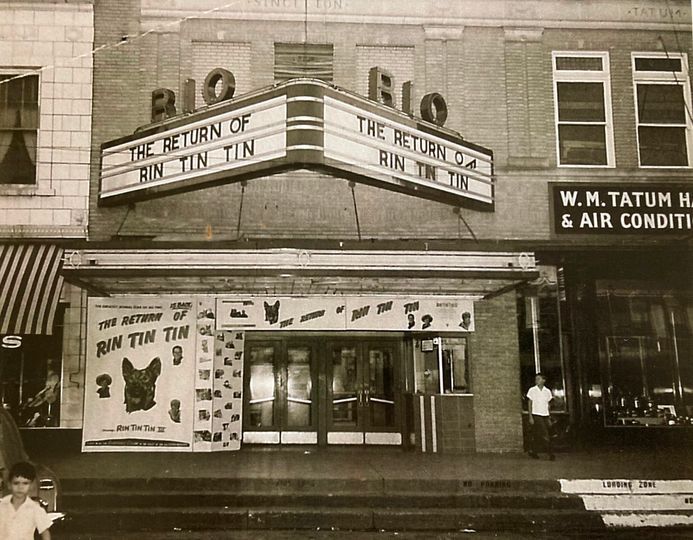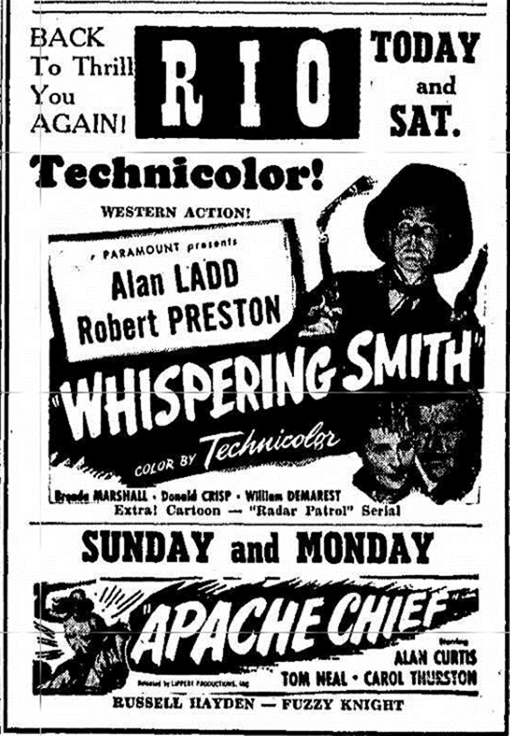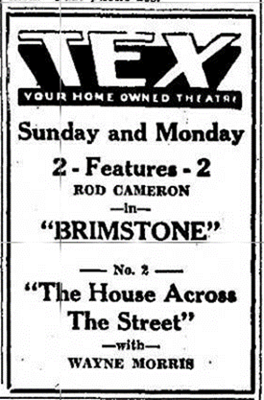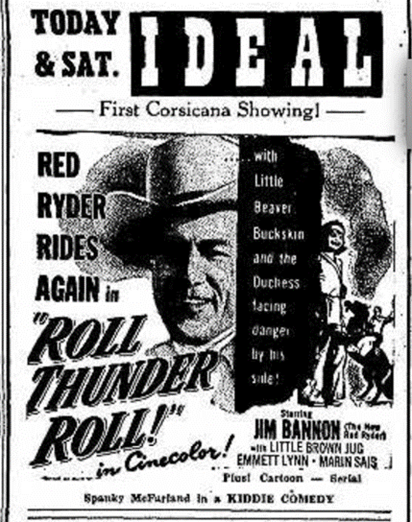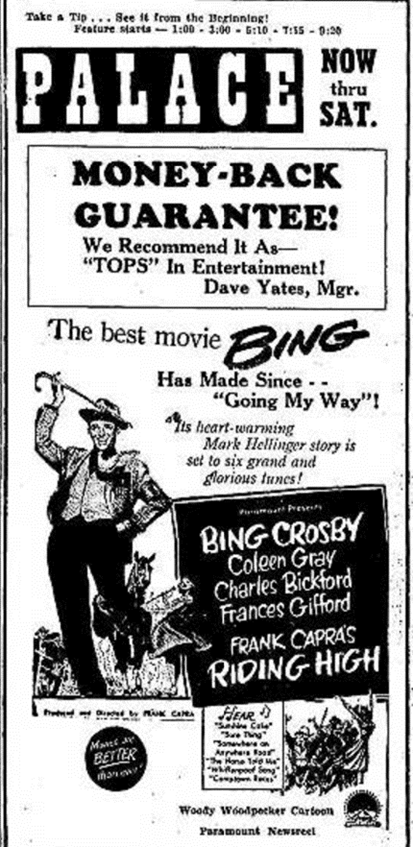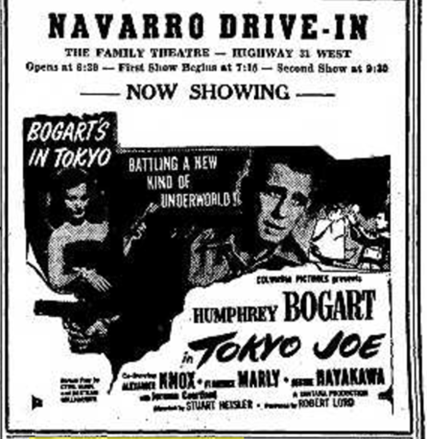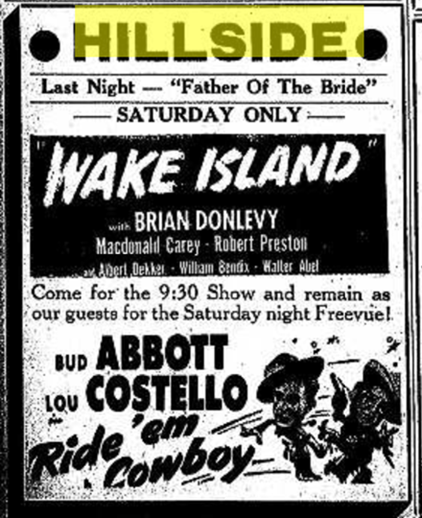|
Early Corsicana Movie Theaters Originally published in "The
Navarro County Scroll", Vol. XVI 1971 ---------------------------------------------------- A history of early movie theaters in Corsicana was reviewed for members of the Navarro County Historical Society by Richard Lancaster, who has taught English and drama at Navarro Junior College for the past six years. Lancaster's presentation was part of a tandem program given at the society's October meeting held Monday evening in the Flame Room of the Lone Star Gas Company. Nelson Ross, also a member of the Navarro faculty and vice-president of the society, presented a series of anecdotes from East Navarro County prepared by the late C. E. McWilliams, longtime Corsicana attorney and former teacher in county schools. Lancaster prefaced his review of Corsicana movie houses by presenting a few facts regarding the development of motion pictures, the first of which were shown in America in New York City April 23, 1896. The audience was fascinated to see people moving on the screen and the actual motion of waves striking the shore, he said. By 1905, the nickelodeon had developed through the efforts of a man named Harris in Philadelphia. Setting an admission price of only five cents for his marvelous moving pictures, he started a trend that was to spread across the country. Based on this information plus research and interviews with local residents of the era, Lancaster conjectures that the first movies were seen in Corsicana some time between 1896 and 1900. He stated that R. W. Wiggins remembers as a lad going down to the Houston and Texas Railway station some time before 1900 to see motion pictures projected in a baggage car at the back of the train. Subject matter was simple - bathing beauties frolicking in the ocean or a moving train captured on film were enough to delight audiences. Sheppard's Great Novelties were brought to the Merchant's Opera House around 1902 or 1903, and in 1903 Edwin S. Porter's "The Great Train Robbery" brought the first thread of a dramatized story to the motion picture screen. Joel Trimble recalled to Lancaster the experience of standing on a muddy lot at the end of Beaton Street where Lorimer's Station is now located and trying to peer above the tall men around him to see pictures that moved. By 1909, there were operating in Corsicana two theaters the Bijou and the Majestic, according to advertisements in the Corsicana Daily Sun. The Bijou may have been located on North Beaton about where McLellan's now stands or somewhere in the 100 Block on West Collin. Based in his research, Lancaster opts for the Collin Street location. He believes the Bijou may have been an early name for the theater bought by M. L. Levine after he came to Corsicana in 1911 with $600 in his pocket to invest in a business. The Majestic, located on Collin at the present site of the Children's Shop, is well remembered by many present-day Corsicanans. It was purchased by J. S. Stout in the late 1800's. An early owner was a man named Boone, a one-armed man who delighted the young fellows with the way he could roll a Bull Durham cigarette with his one hand. W. T. Carringan was another owner of the Majestic which was managed by his brother Lafayette in 1909. It was later owned by a man named Sappington, who was described as "friendly", and a Charles St. Clair. T. D. Garner was the best remembered owner. He bought the Majestic Sept. 1, 1911 and paid around $5,000 for it. Under his management the theater did well. He enlarged the seating capacity to 400 and called it the "House of Features". There were amateur nights featuring guitarists, gymnasts and jugglers, and contestants would come from miles around to compete for the ten to 20 dollar prizes. Garner himself was a colorful figure. A contortionist, he had traveled with Ringling Brothers and had even given a command performance for the royal family of England. The Majestic has been described as the first "elegant" movie theater in Corsicana. It boasted sloping floors and a carpeted foyer and was the first theater to have an organ. Garner sold the theater to J. S. Eubanks, who sold it to his father-in-law, Thompson, and the property passed into the hands of M. L. Levine in 1917. In 1910 a young boy of 12, John Remonte, came to Corsicana from Fort Worth and went to work in the theater owned by A. J. Stopple, operating a phonograph which played the Edison and Columbia cylinder records. There was even a volume speaker to attract passersby to the theater. In 1911 when Max Levine got off the train in Corsicana with $600 to invest in a business he found the Stopple theater available for $1,600. After consulting his father-in-law, Goodman of Waco, he purchased the theater located about where Dyer's show department now is and named it the Cozy Theater. John Remonte, an inventor by nature, continued to work for Levine. He jury-rigged an electric motor to the projector to avoid having to crank it by hand and was forthwith arrested for violating the fire code. Since film was highly flammable special precautions had to be taken to protect the theater audience from danger of fire in the projection booth. Remonte was finally able to convince the fire chief that his invention was not a hazard. Shows at the Cozy usually involved three reels of 20 minutes each, two features and one new reel or serial, such as "The Perils of Pauline". Young Remonte even tried his hand at writing scenarios, but without success. In the period from 1900 to 1913 everybody wanted to get into the theater business, Lancaster said. The Gem was located at 114 N. Beaton and was operated in 1913 by Robert Huff and Fred Newman and was sold about 1914 to Billy Kutchigus. The Queen Theater opened on March 17, 1913. It was managed by T. D. Garner and owned by J. T. McClure, a dairyman. The Queen had chorus girls who lived in "The Rookery" above Kiber and Cobb on the J. M. Dyer corner. The fifth Avenue Theater was a Negro enterprise managed by a black man named Reed Conner. One anecdote concerning the theater is that a man named June Flowers who was in the audience during a western film drew his gun and shot at the villains on the screen during one exciting point. By 1912, Max Levine was ready to build a new theater. His Cozy Theater only had a seating capacity of 200, and when it was completed his Ideal Theater seated 500. On April 6, 1912, he purchased the property on which to build the new plant for $3,140, and the Ideal Theater opened its doors at 7 p.m. Monday, Feb. 13, 1913. The theater boasted an orchestration as big as any church organ in town, and it also had a player piano equivalent to a ten-piece orchestra. John Remonte rigged an electric clock to operate a synchronized arrow outside the theater to indicate the point to which the program had progressed. Louis Levy was also one of the theater's projectionists. In July 1917, Levine hired architect M. T. Horn and J. E. Metcalf, contractor, to remodel the theater and add a roof garden at a cost of something over $29,000. It was at this point, the beginning of a new era, that Lancaster chose to end his story. The Ideal Theater, now under condemnation, was the scene in his boyhood of many happy hours watching the adventures of Johnny Mack Brown and Randolph Scott. Lancaster confessed that his research was the result of a recurring dream about the Ideal Theater. He became obsessed with the idea of finding out something of its early history. 2/1/2004 IRVIN SAMUELS: Many memories of movies in Corsicana from yesteryear It seems that my memories of the old movie houses in Corsicana created quite a bit of interest. This being the case, I thought that I would elaborate (as much as my memory will allow) on the other forgotten movie theatres that once stood. On Collin Street, where the Children's Shop is now located, stood the Majestic. Before my time it was called The Cozy. I can still picture the huge blue flickering klieg light of the projector. Like our TV's, it extended from the rear of the projection booth and was easily seen on the outside of the theatre. Picturing the Majestic in my mind, it was not very large. There were two aisles consisting of three seats on each side and the middle section had about 10 seats. It was approximately 20 rows deep and had an orchestra pit. The price of admission was 5 cents for children and 10 cents for adults. The theatre was always full. The length of the shows were shorter than today's movies. The Majestic showed nothing but westerns and changed features daily. The famous western stars in that era were Tom Mix, Hoot Gibson, Buck Jones and William S. Hart. The famous canine stars then were Rin Tin Tin and Strongheart. Movie projection was not what it is today. Each reel had to be changed manually. This meant a two- to five-minute delay in the continuous showing of the movie. The audience accepted this as routine. However, many times the film would break and of course had to be spliced. The time it took to do this would vary. The younger audience would show their impatience -- by clapping their hands, stamping their feet, and whistling. Later in the afternoon a three-piece band would appear in the orchestra pit and would accompany the film. I think the musicians were late as they had other jobs and were moonlighting. The band consisted of a bass, a violin and a piano. The trio also played for a few dances around town. In the summer they would go around town serenading, which is another story in itself. I will never forget the first movie cartoon that I saw at the old Majestic. It was "Felix the Cat." How many of you remember that old comic strip? At that time I thought that cartoon was the most wonderful thing I had ever viewed. Sometimes after the movie, if we had any change left, we would go to the corner (where the late Dyer's department store is located) to Kiber and Cobb's Confectionery. There we would have homemade ice cream -- I can almost taste it now. This was indeed a real treat! You see, we had no real refrigeration in those days. We could not open a door and dish out ice cream whenever we desired it. We either had to purchase it at a commercial shop or turn the crank on the wooden bucket of our ice cream freezer. During this era there was one other theatre in Corsicana -- The Grand. It was on Beaton Street where the Grace Sewing Machine Co. is located. The Grand has a special place in my memory. Every Friday and Saturday, they would run a serial. The serial would follow the main feature and would be about two reels in length. Sometimes the serials would have from 10 to 16 episodes. "The Pearls of Pauline" was the most famous serial of all. Pauline would get into the most terrible predicament -- like being strapped to a log in a lumber mill which is moving closer to the huge rotating saw, going over a waterfall tied in a canoe, tied to a railroad track with the locomotive moving closer, etc. Between binding the serial heroines to sundry props and cowboys trick lassoing, lots of rope was used in Hollywood during the early days of movies. Of course, you would have to wait until the next weekend to see if Pauline would be saved. She always was. Pauline was played by Ruth Roland. TV was never this exciting. Other actors in the silent movie era were: Douglas Fairbanks Sr., Mary Pickford, Charlie Chaplin, Wallace Berry, Clara Bow, Norma Shearer, Ramon Navarro, Buster Keaton, Harold Lloyd, Ben Turpin, The Keystone Kops, Dorothy and Lillian Gish, and of course Rudolph Valentino. Who could forget his movie "Blood and Sand!" Movies played an important role in our lives. Radio was in its infancy. The old movies were different from today's. A kiss never lasted over five seconds, bathing suits were below the knees, ladies necklines were almost up to their chin, "Gosh" was almost a swear word and cowboys never kissed their girls. The big difference in today's movie that I see is that the good guys may wear "A Black Hat." ---------- The Irvin Sameuls column originally published May 17, 1994 in the Daily Sun.
Corsicana Movie Theater Advertisements 1950s
The Corsicana Daily Sun - Fri., May 5, 1950 – submitted by Diane Richards
The Corsicana Daily Sun - Fri., May 5, 1950 – submitted by Diane Richards
The Corsicana Daily Sun - Fri., May 5, 1950 – submitted by Diane Richards
The Corsicana Daily Sun - Fri., May 5, 1950 – submitted by Diane Richards
The Corsicana Daily Sun - Fri., May 5, 1950 – submitted by Diane Richards
The Corsicana Daily Sun - Fri., Sep. 8, 1950 – submitted by Diane Richards
|
